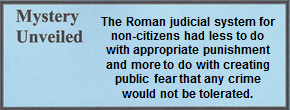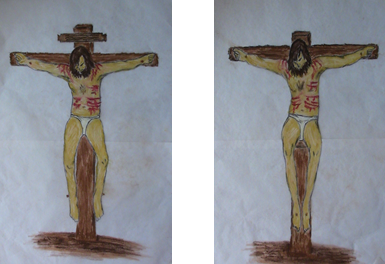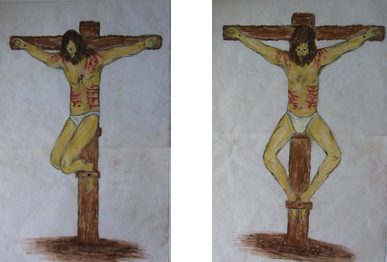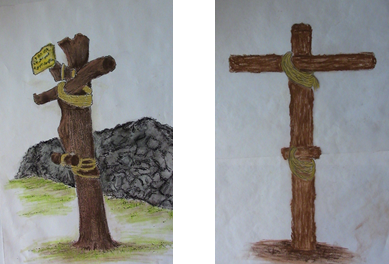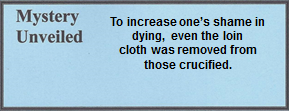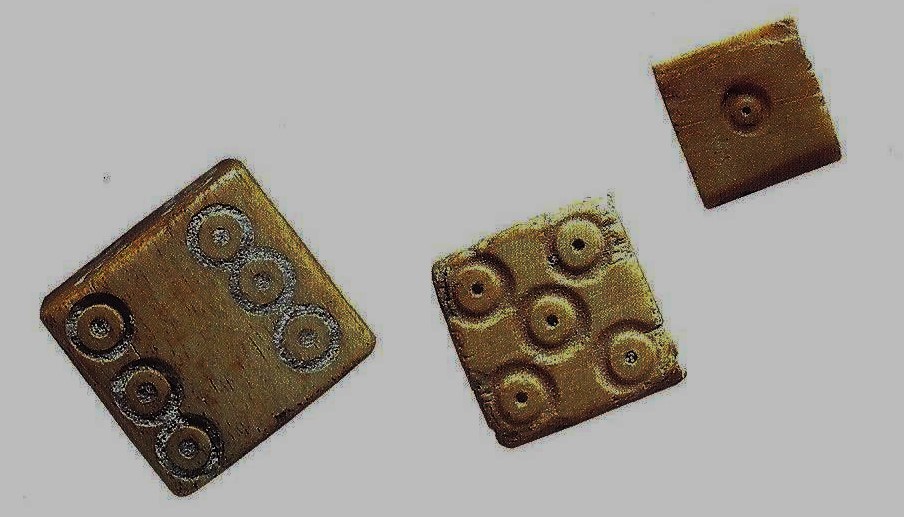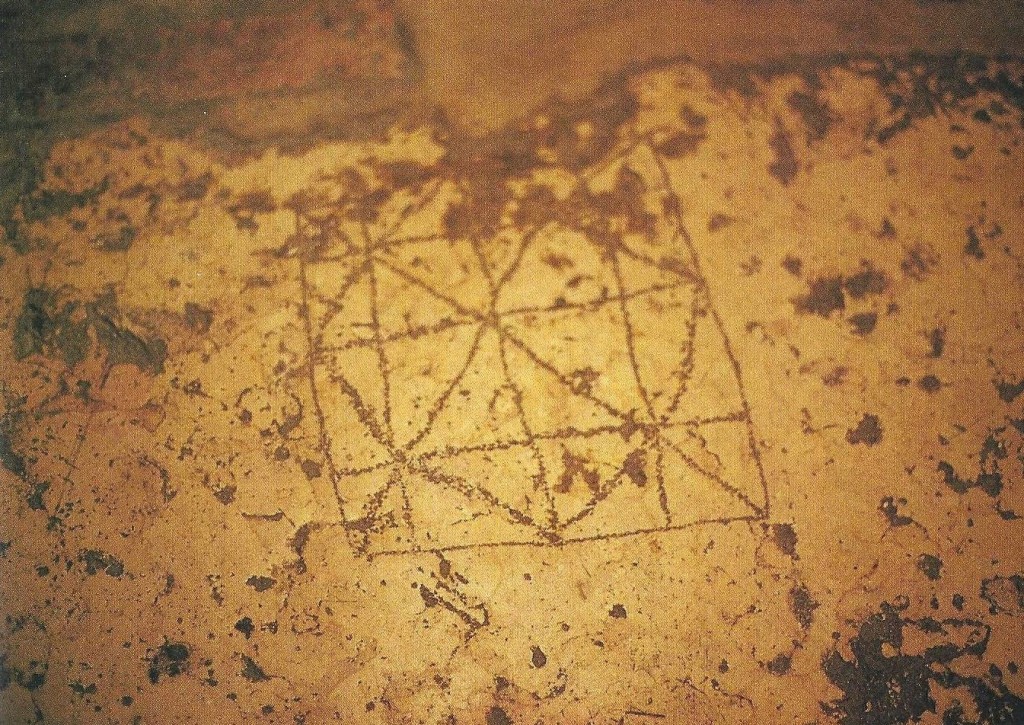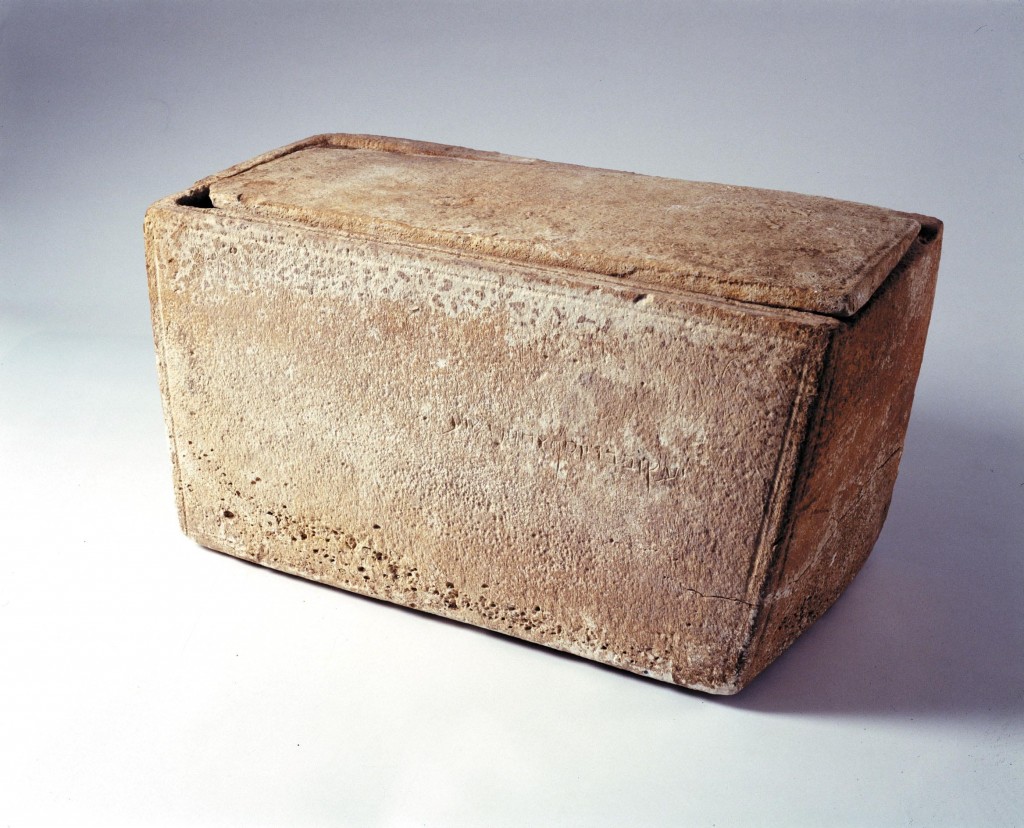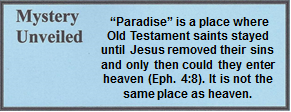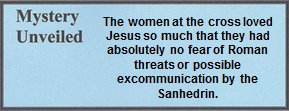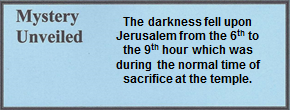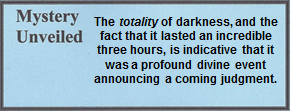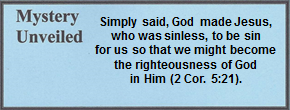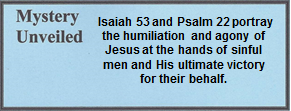16.01.18 Jn. 19:30a; Lk. 23:46a; Jn. 19:30b (See also Mt. 27:50; Mk. 15:37) On the Cross
JESUS DIES
Jn. 30a When Jesus had received the sour wine, He said, “It is finished!”
Lk. 46a And Jesus called out with a loud voice, “Father, into Your hands I entrust My spirit.”
Jn. 30b Then bowing His head, He gave up His spirit.
The most detailed description of how Jesus died is found in Psalm 22, while Isaiah 53 has the physical suffering up to the time of His death and atonement. Jesus was sacrificed as the Lamb of God to remove the sins of the world. Of all the individuals mentioned in Scripture, Jesus was the most abused person. He died precisely at the same time the lambs were being sacrificed in the temple. These lambs were a covering for the sins of each family, but Jesus died for the sins of humanity. The symbolism was underscored by the timing of the sacrificial death of Jesus (Jn 1:24; 1 Cor. 5:7). One cannot study the life and death of Jesus without taking into account the symbolism that was underscored by the timing of the events together.
Note the words of Melito:
Nature trembled and said with astonishment: What new mystery is this? The judge is judged and remains silent; The invisible One is seen and does not hide Himself; The incomprehensible One is comprehended and does not resist; The immeasurable One is measured and does not struggle; The one beyond suffering suffers and does not avenge Himself; The immortal dies and does not refuse death. What new mystery is this?
Melito of Sardis, Homily on the Passion 68[1]
The words of Isaiah continue…
5 But He was pierced because of our transgressions,
crushed because of our iniquities;
Punishment for our peace was on Him,
and we are healed by His wounds.
6 We all went astray like sheep;
We all have turned to our own way;
And the Lord has punished Him
for the iniquity of us all.
7 He was oppressed and afflicted,
yet He did not open His mouth;
Like a lamb led to the slaughter
and like a sheep silent before her shearers,
He did not open his mouth.
8 He was taken away because
of oppression and judgment;
and who considered His fate?
For He was cut off from the land of the living;
He was struck because of my people’s rebellion.
Isaiah 53:5-8
“It is finished.” The Greek word for this phrase, tetelestai, means that a work has ended and the goals have been accomplished.[2] Only in Christianity does God say “it is finished.” It was another way of saying, “the debt of sin has been paid.” The sixth saying of the cross was the announcement that His ministry had concluded. It was at the 9th hour of the day (3:00 p.m.), the time when the priest stood at the pinnacle of the temple and blew the shofar. The sound of the ram’s horn announced the sacrifice of thousands of lambs, which faithful Jews brought to the temple for their sin sacrifices. By His incredible grace, a person needs to come only as he/she is and accept His work of salvation. Other religions, both ancient and modern, insist that a good attitude and many good deeds or works for the service to humanity accomplish salvation.
It is significant that the cross demonstrates the identification and solidarity Jesus has with His people, for thousands of them had been crucified unjustly by the religious leaders, Greeks, and Romans. Jesus demonstrated that the greatest defeat can, by Divine grace, be transformed in the the greatest victory.
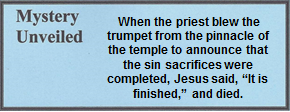
“Father, into Your hands I entrust My spirit.” This final and seventh statement demonstrates that Jesus was in control of His death. Jesus dismissed His Spirit. He chose to die for the sake of a lost humanity. His work was completed in precise detail as predicted by the prophets of centuries past. No other prophet in the future could add anything to the work of Jesus. This was a fulfillment of Exodus 12:46 and Zechariah 12:10, which Paul referred to in 1 Corinthians 5:7. The Romans and Sadducees most certainly did all they could to kill Him, but the only reason Jesus died is because it was the plan of the Almighty Father, carried to completion by His Son Jesus. Jesus could have chosen to live but chose to die for our sake. These words were the prophetic prayer of David and the disciple-apostle John also wrote about it in his letter to the Philippians.
5 Into Your hand I entrust my spirit;
You redeem me, Lord, God of truth.
Psalm 31:5
7 Instead He emptied Himself
By assuming the form of a slave,
Taking on the likeness of men.
And when He had come as a man in His external form,
8 He humbled Himself by becoming obedient to the point of death–
even to death on a cross.
Philippians 2:7-8
These words describe not only how He died, but also how He lived. It has been said that how a man lives is how he dies. This was true of Jesus and every one of His apostles. David looked forward, by faith, to the time when man could enjoy complete restoration and the renewal (recreation) of a sinful heart. For this reason David was called the man after God’s own heart.
The death of Jesus had a profound effect on those whom He healed, on those whom He taught, and those who believed He was truly sent from God. They struggled with two disappointments:
- Their Messiah was dead – the One who raised the dead and healed the sick.
- Their Messiah was cursed by God according to Deuteronomy 21:22-23.
Without question this was the worst and the greatest Passover in Jewish history. That was about to change at sunrise on the first day of the week. But even then, the events needed to be understood. Witnessing the events did not necessarily bring understanding. Therefore, some twenty to thirty years later the Apostle Paul addressed these issues in Galatians 3:10-14, Philippians 2:7-8 and 4:7-8.
16.01.18.Q1 Why did Jesus die?
Jesus died for two reasons:
- He died because He did not conform to the ordinances which the religious leaders had profanely added to the Word of God.
- Most importantly, He died so that humanity can have eternal life with Him. His death had been symbolized as the Lamb of God for nearly fifteen centuries. He died that mankind can be reconciled unto Himself. Reconciliation (Gk. apokathistemi) is to restore to an original state,[3] which is, in effect, the Kingdom of God living within those who chose to follow Him. Jesus died because He was the Lamb of God, who was crucified for the sins of humanity, and He died because He was the King of Israel.
The day shall come when He will return and hold His rightful position of not only King of Israel, but king of the world. However, the theological answer to this question in found most frequently in confessional statements in the Pauline epistles, where the apostles stated “Christ died for our sins” or “Christ died for us.”[4] Paul understood that the “message of the cross” (1 Cor. 1:18) is a “message of reconciliation” (2 Cor. 5:19) to unite humanity with God. Second Corinthians 5:21 pointedly states that “God made him (Jesus) sin, who had no sin to be sin for us, so that in him we might become the righteousness of God.”
Video Insert >
16.01.18.V Man in the Image of God: A Divine Plan from Eernity Past. Dr. John Soden discusses man’s problem of sin that began in Genesis, and God’s wonderful plan to resolve the issue.
The death of Jesus is known as the “shedding of blood,” meaning His blood. Since the life is in the blood, the shedding of blood is synonymous with death.[5] Modern scholarship is challenged by the fact that Paul said in 1 Corinthians 15:3 that “Christ died for our sins in accordance with the Scriptures,” but he never referred to those Scriptures. Evidently, these were not significant to him, or he assumed that his readers were familiar with them. Jesus died to restore man into His image, the image of God – the imago dei (Latin phrase).
16.01.18.Q2 What is the Significance of “Shed Blood?”
Without the shedding of blood (death) there is no remission of sin (Heb. 9:22). As stated previously, the blood of bulls and goats sacrificed on the Day of Atonement only covered the sins of the people, but the blood of Jesus completely removed the sin. Furthermore, the Old Testament sacrificial system did not provide for the covering of the sins of murder and adultery, but the sacrifice of Jesus did. David realized the fallacy of the sacrificial system after he confessed to these two sins, which is why he wrote “create in me a new heart” (Ps. 51:10). His writing would become a foundational prayer in the heart of every new believer seeking the Kingdom of God.
This question has always been, and continues to be, one of the most important questions of life. The essence of His life and death is to restore humanity to a right relationship with Himself. The message has not changed during the centuries. Note the following comments written hundreds of years ago.
To whom was the blood paid out that was shed for us, and why was it shed?…We were in bondage to the evil one, sold under sin, and receiving pleasure in exchange for wickedness. If a ransom belongs not to someone else but to him who holds in bondage, I ask you, to whom was this paid, and for what reason? If to the evil one, O what an outrage!
If to the Father, first I ask, how can that be? For we were not being detained by Him; and second, why would He be delighted by His only begotten Son…surely it is evident, however, that the Father did receive (the sacrifice of His Son), though neither asking nor demanding it, but because of His plan of redemption and so that might we be sanctified by the Humanity of God.
Gregory of Nazianzus, Second Oration on Easter[6]
Jesus Christ our Lord, who, on account of His great love, became what we are so that He might bring us to what He Himself is.
Irenaeus, Against Heresies[7]
The Sacrificial Victim was offered for all mankind, and was sufficient to save all, but it is believers alone who enjoy the bounty thereof.
John Chrysostom, Homilies on the Epistle to the Galatians[8]
Not one reason, but many. First, that he might have dominion over the living and the dead. Second, so that, by being sacrificed for us and by becoming a cursed thing on our behalf, He might wipe away our sins. Third, so that He might be offered to the God of all on behalf of the whole world. Fourth, so that He might Himself, with secret words, bring about the destruction of the demoniacal workings which lead so many astray. The fifth is this: so that holding out to His acquaintances and disciples the hope of life with God after death…He might bring on to completion those already more willing and those of greater courage; and so that with His rejection He might proclaim a religious polity to all, to Greeks and barbarians alike.
Eusebius, Demonstrations of the Gospel[9]
Jesus, the perfect human specimen who never sinned, took upon Himself the punishment we deserve for our sins. Phrases such as “His shed blood,” “His death on the cross,” “His sacrifice,” all refer to His cruel death through which we can obtain forgiveness. However, as with any gift, it must be accepted. The phrase “received Jesus,” simply means one has accepted the gift of salvation (saved from the penalty of sin, which is eternal death), made a decision to become disciplined in a life of faith in Jesus, and will develop an attitude of living a holy lifestyle. When He hung dying on the cross, He looked into the future and saw every one of us; He saw you reading this and for Him the old rugged cross was a joy that you might live (Heb. 12:2).
The Jews understood very well the doctrine of sin in terms of willful disobedience and rebellion. What is amazing is that they either had no knowledge of the doctrine of original sin or failed to recognize it. This doctrine states that the nature of all sin originated in the Garden of Eden with Adam and Eve. It further states that because of the original sin, all people have a sin nature and are guilty before a pure and holy God. Mankind’s only hope is found in Christ Jesus. This was a totally new concept for first century Jews and Gentiles. There is no reference to this concept in any rabbinical writings, nor in any other religion.
A blood sacrifice of some kind as a sin payment was well established in all ancient cultures, as handed down from the dawn of creation. The spilling or shedding of blood in biblical terms is always associated with the death of an innocent person or has reference to death through sacrifice for payment of sin. When Adam and Eve sinned in the Garden of Eden, God clothed them in skins, meaning that God sacrificed an innocent animal for the sins of the first two people. They instructed their sons to present a sacrificial animal to God (Gen. 3:21; 4:4; Heb. 11:4). When the Israelites arrived at Mount Sinai, the Levitical covenant was sealed with a blood sacrifice. It stated, “For the life of a creature is in the blood, and I have given it to you to make atonement for yourselves on the altar; it is the blood that makes atonement for one’s life” (Lev. 17:11). In that sacrifice, the sins of the people were covered or “atoned.” The death of Jesus, however, was a substitute death for our sins, because now no longer do animals have to be killed nor are our sins covered, but they are completely removed. Therefore, we have a better covenant, a victory in this life and eternal life, all because of the sacrificial death of Jesus on the cross.[10]
16.01.18.Q3 How old was Jesus when He died?
Luke recorded that Jesus was about 30 years of age when He began His ministry. This follows the Jewish tradition regarding the proper age when a man was to begin priestly duties in the temple. John records at least three Passovers which Jesus attended (2:13; 6:4; 11:55) during His public ministry, but that does not rule out the possibility that other Passovers were not recorded. Jesus died when Tiberius was Caesar, Pontius Pilate was the prefectus,[11] Antipas was the tetrarch, and Joseph Caiaphas was the high priest in the temple. Records indicate that Tiberius died on March 16, A.D. 37, and Pilate ceased to be in power shortly before the Passover in A.D. 36. Caiaphas became High Priest shortly after the Passover in A.D. 18 and served until the year 36. Therefore, if Jesus was born between 6 – 4 B.C., and died in A.D. 30, His age would have been between 33 to 35 years.
16.01.18.Q4 What was the year of His death and resurrection?
There were five major considerations to be evaluated when calculating the date of His death and resurrection of Jesus, The result is that most scholars have concluded on two possible dates, A.D. 30 and 33.[12]
- How is the 15th year of Tiberius reckoned?
- How is the Passover in John 2 dated and how many Passovers are recorded in the gospels?
- How long was the ministry of Jesus, and
- The evidence in the Mishnah which indicates that the “mysteries” four decades before the destruction of the temple were the result of the crucifixion of Jesus (See below).
- Evidence from secular sources.[13]
Part of the difficulty in any time calculation, and the apparent differences between John and the Synoptic gospels, is that the Jews had two calendars (civil and religious). Josephus recorded that Moses introduced a year of holy days and religious festivals that began with the month of Nisan. This was the month of the Exodus and Passover.[14] The celebration of Resurrection Day, a/k/a Easter, is the fulfillment of Passover and is reckoned on the solar-lunar cycles, coming on or after the spring vernal equinox (March 21). Moses, however, also kept the civil calendar year that was for buying, selling, and secular affairs. The civil year begins with Rosh Hashanah in the month of Tishri (1 Kg. 8:2).[15] Obviously historic investigations can be rather challenging. However, in light of the mysteries that occurred some forty years before the destruction of the temple (see below), there is a majority opinion of scholars that Jesus died in the year A.D. 30. Regardless of the accounts, it is known that,
- Jesus existed, and
- He was somewhat older than the 33 years of age that is commonly thought of today.
A strong argument that supports an A.D. 30 date is the statement shouted by the Sadducees, “You are no friend of Caesar.” These words are steeped in the political quagmire in Rome that was caused by personal confidant turned traitor, Sejanus. As stated previously, Sejanus feared for his life and position and did not want to lose his amici Caesaris, or “friendship with Caesar” and face execution (which happened in October, A.D. 30).[16] In that year he was at the height of his power and the emperor’s life was in chaos. If the crucifixion of Jesus had occurred in the year A.D. 33, there would have been no reason for the Sadducees to try to intimidate Pilate with this statement.[17] This important point has been overlooked in nearly every study of dating the crucifixion.
Finally, critics have argued that if Jesus was so important, how could His date of birth[18] and crucifixion be forgotten? Their implication is, of course, that in the first century Jesus was not an important figure. The answer lies in the fact that at this time and in this culture, birthdates and death dates were not as significant as what a person did in life. In Western thinking a greater emphasis is placed on these dates, but not in biblical times. Many people of this era did not know when they were born. Very few biblical figures have the date of birth recorded, so the biblical writers cannot be faulted. As some have said, “Uncertainty and debate regarding the precise date of an occurrence is not necessarily an indication of unhistoricity.”[19]
While there are various viewpoints, the following outline is one to which many scholars agree.[20]
Saturday, Nisan 8, A.D. 30 (six days before the final Passover – Jn. 11:55)
Jesus arrived at Bethany.
Jesus was anointed at the house of Simon the leper (Mt. 26:6-13; Mk. 14:3-9; Jn. 12:1-8).
Sunday, Nisan 9
A large crowd came to see Jesus at Bethany (Jn. 12:9-11).
Monday, Nisan 10 (the next day – Jn. 12:12)
Jews selected their lambs, which would live with them, be examined for purity between the 10th and the 14th day of Nisan, and be sacrificed on Passover (Ex.12:3-6).
Triumphal entry into Jerusalem as the Paschal lamb (Mt. 21:1-9; Mk. 11:1-10; Lk. 19:28-40; Jn. 12:12-19).
The Kingdom of God is no longer offered to the Jewish nation, but Jesus speaks of national judgment.
Jesus visited the temple (Mt. 21:10-11; Mk. 11:11).
Jesus returned to Bethany.
Tuesday, Nisan 11
Return to Jerusalem, fig tree cursed (Mt. 21:18-19; Mk. 11:12-14).
Temple cleansed (Mt. 21:12-13; Mk. 11:15-17; Lk. 19:45-46).
Religious leaders plot to kill Jesus.
Jesus left Jerusalem, probably to Bethany (Mk. 11:18-19; Lk. 19:47-48).
Wednesday, Nisan 12
Return to Jerusalem, disciples saw the dead fig tree (Mt. 21:20-22; Mk. 11:20-26).
Debate with religious leaders at the temple (Mt. 21:23 – 23:39; Mk. 11:27 – 12:44;
Lk. 20:1 – 21:4).
Left the temple to give the Olivet Discourse on the Mount of Olives (Mt. 24:1 – 25:46; Mk. 13:1-37; Lk. 21:5-36).
Jesus predicted His crucifixion in two days (Mt. 26:1-5; Mk. 14:1-2; Lk. 22:1-2).
Judas planned to betray Jesus (Mt. 26:14-16; Mk. 14:10-11; Lk. 22:3-6).
Thursday, Nisan 13
Jesus and disciples prepare the Passover lamb (Mt. 26:17-19; Mk. 12-16; Lk. 22:7-13).
Passover celebrated in the Upper Room (Mt. 26:20-30; Mk. 14:17-26; Lk. 22:14-30; Jn. 13:1 – 14:31).
They left the Upper Room.
Jesus prays for His disciples (Mt. 26:30-35; Mk. 14:26-31; Lk. 22:31-39; Jn. 15:1 – 18:1).
They arrive in the Garden of Gethsemane.
Jesus in agony in the Garden (Mt. 26:36-46; Mk. 14:32-42; Lk. 22:39-46; Jn. 18:1).
Jesus betrayed late night (Mt. 26:47-56; Mk. 14:43-52; Lk. 22:47-53; Jn. 18:2-12).
First night trial by Annas, second night trial by Caiaphas (Mt. 26:57-75; Mk. 14:53-72; Lk. 22:54-65; Jn. 18:13-27).
Friday, Nisan 14 (reckoned to the Julian calendar: April 3, A.D. 30)[21]
Third trial by the Sanhedrin in early morning.
Fourth trial by Pilate.
Fifth trial by Herod Antipas.
Sixth trial by Pilate. (Mt. 27:1-30; Mk. 15:1-19; Lk. 22:66 – 23:25; Jn. 18:28 – 19:16).
9:00 a.m. Jesus crucified.
3:00 p.m. Jesus died (buried before sundown).
(Mt. 27:31-60; Mk. 15:20-46; Lk. 23:26-54; Jn. 19:16-42)
3:00 p.m. Jews sacrificed their Passover lambs (Ex. 12:6; 1 Cor. 5:7).
Saturday, Nisan 15
The body of Jesus lies in the tomb.
Jews secured Roman guards at the tomb (Mt. 27:61-66; Mk. 15:47; Lk. 23:55-56).
Sunday, Nisan 16
Jesus resurrected from the dead (Mt. 28:1-15; Mk. 16:1-13; Lk. 24:1-35).
Jesus is a type of offering of First Fruits which was offered the day after the Sabbath (Lev. 23:9-14; 1 Cor. 15:23).
Finally, it should be noted that several studies have been done concerning the year the 14th day of Nisan was on a Friday.[22] Those years were A.D. 27, 30, 33, and 36. Since the years 27 and 36 are highly unlikely, the only two possible years for His death and resurrection, as previously stated, are 30 and 33.
16.01.18.Q5 Are there other ancient writings of tortures and crucifixions?
The Assyrians may have developed the precursor to crucifixions when they impaled a victim on a pole. Some scholars believe that the practice originated in Persia as part of a religious worship of Ormuzd (also known as Ahura Mazda), the chief deity of creation, light and goodness in Zoroastrianism.[23] Because a criminal was considered evil, he was crucified “above the earth” as not to defile the earth.[24] From the Persian kingdom the practice was passed on to Carthage in North Africa. When the Romans conquered the region they accepted the execution method, but used it for rebels, runaway slaves and for criminals who committed the most horrific crimes. Roman citizens were exempt from it.
What is known, however, is that this horrible method of execution was practiced by the Scythians, some Europeans (Celts, Germans, and Britons), Greeks, Parthians, and Indians. While some historic sources are questionable, it is clear that the Romans were not the instigators of this method.
While the Roman Empire officially ended the practice of crucifixion in the year 315, it unfortunately, continued. There are both ancient and modern records of such horrific executions. This form of execution reveals the depravity of human nature. Below are a few examples.[25]
522 B.C. The Greek historian Herodotus, writing about 450 B.C., mentions crucifixion three times in his work, The Histories (3.125.2-3). In one of his narratives, he described torture that preceded the crucifixion. He mentioned Polycrates who was a tyrant on the island of Samos. He was eventually captured by Oroestes, the Persian governor of Sardis, who tortured and crucified him. It should be noted that not all ancient historians agreed with Herodotus, as some called him “the father of lies.”
519 B.C. Herodotus reported (The Histories) that the Persian King Darius I the Great, had 3,000 rebellious citizens crucified.
332 B.C. After Alexander the Great conquered Tyre, he had 2,000 Tyrians crucified along the beach. The account was recorded by Roman senator Quintus Curtius Rufus in his book, History of Alexander the Great.
167 B.C Antiochus IV Epiphanes, the Syrian-Greek ruler put to death anyone who attempted to observe the Jewish rites of religion. See 03.04.19 for more details concerning this madman. Some scholars consider Antiochus to have been a “type and shadow” of the future Antichrist.[26]
90 – 88 B.C. Eighty women and 800 Pharisees were crucified who were suspected of being witches. See 03.05.10.
A.D. 64 Some scholars have established the date of October 13, as the day that Peter was crucified by Nero. His death is mentioned in a letter written by Clement, Bishop of Rome (A.D. 88-97) to the Corinthians. A second century book, The Acts of Peter, says he was crucified upside down because he was not worthy to die in the same manner as was his Lord. Eusebius recorded the same account.[27]
A.D. 66-70 Josephus wrote of the actions of the Roman procurator Gessius Florus, whom William Whiston considered to be the most wicked of all procurators.[28] Florus was made ruler of Judea shortly before the First Revolt (A.D. 66-70). When he exercised his demonic power over the Jewish people, he sent soldiers into the Upper Market Place to plunder it, but the soldiers did far more than plunder goods.
So the soldiers, taking this exhortation of their commander in a sense agreeable to their desire of gain, did not only plunder the place they were sent to, but forcing themselves into every house, they slew the inhabitants; so the citizens fled along the narrow lanes (streets) and the soldiers slew those that they caught, and no method of plunder was omitted; they also caught many of the quiet people and brought them before Florus, whom he first chastised with stripes (flogging) and then crucified.
Josephus, Wars 2.14.9 (306)
A.D. 66-70 Josephus continues this account to record that five hundred or more Jews were captured daily during the First Revolt. The killing machine of the Romans continued to the point that they exhausted their supply of trees and crosses. With a demented sense of humor, the Roman General Titus ordered two people to be crucified on every cross, one on either side.
So the soldiers, out of the wrath and hatred they bore against the Jews, nailed those they caught, one after one way, and another after another way, to crosses by way of jest. When their multitude was so great, that room was wanting for the crosses and crosses wanting for the bodies.
Josephus, Wars 5.11.1 (451)
Philo, who was a Roman senator and contemporary of Josephus, preserved two other accounts of scourging and crucifixion. He described the mocking delight the executioners had in their work.
And those who did these things, mimicked the sufferers, like people employed in the representation of theatrical farces; but the family and friends of those who were the real victims, merely because they sympathized with the misery of their relations, were led away to prison (and) were scourged, were tortured, and after all ill treatment, which their living bodies could endure, found the cross the end of all, and the punishment from which they could not escape.
Philo, Against Flaccus 72[29]
Philo’s second description of a crucifixion also reveals how the depraved Romans thought of it as a comedy to persecute and execute in a theater with musicians and dancers. The depravity of humanity is, at times, beyond comprehension.
I have known instances before now of men who had been crucified when this festival and holiday (birthday of the emperor) was at hand, being taken down and given up to their relations in order to receive honors of sepulture, and enjoy such observances as are due the dead; for it used to be considered that even the dead ought to derive some enjoyment from the natal festival of a good emperor, and also that the sacred character of the festival ought to be regarded. But this man did not order men who had already perished on crosses to be taken down, but he commanded living men to be crucified, men to whom the very time itself gave, if not entire forgiveness, still, at all events, a brief and temporary respite from punishment; and he did this after they had been beaten by scourging in the middle of the theater and after he had tortured them with fire and sword; and the spectacle of their sufferings was divided, for the first part of the exhibition lasted from morning to the third or fourth hour, in which the Jews were scourged, were hung up, were tortured on the wheel, were condemned, and were dragged to execution through the middle of the orchestra; and after this beautiful exhibition came the dancers, and the buffoons, and the flute players, and all the other diversions of the theatrical contests.
Philo, Against Flaccus 83-84
To illustrate the horrors of this act, the Apostle Andrew was crucified in a manner to maximize pain and agony. He was crucified on a low cross to permit wild animals and dogs to feast on his flesh while he was still alive. The account, recorded in an extra-biblical book, reflects a common method of crucifixion.
He (the Proconsul Aegeates) commanded that Andrew be flogged with seven whips. Then he sent him off to be crucified and commanded the executioners not to impale him with nails but stretch him out tied up with ropes, (and) to leave his knees uncut, supposing that by so doing he would punish Andrew even more severely…The executioners … tied up only the feet and armpits, without nailing up his hands or feet nor severing his knees because of what the proconsul had commanded them, for Aegeates intended to torment him by his being hung and his being eaten by dogs if still alive at night.
The Acts of Andrew: The Passion of Andrew 51.1; 54.4[30]
480 On September 18 the 150,000 man army (huge for ancient times) Persian army led by King Xerxes, wiped out King Leonidas and his small army that had less than 10,000 soldiers. When the battle was over, Xerxes ordered that the head of Leonidas be cut off and his body crucified.
1920 Archbishop Joachim of Sebastopol, a city in the Ukraine (Soviet Union), was crucified upside down on the royal doors of the Sebastopol Cathedral. It is believed that local Bolsheviks committed the crime.
2006 The Assyrian International News Agency reported that a 14-year old Christian boy was crucified in Basra, Iraq in early October. Another news agency also reported the incident, but neither had confirmed details. Although rarely reported in the Western news media, crucifixions are increasing dramatically today in Muslim countries where radical Muslims hold government power.[31]
Critics who have stated that the narrative of the crucifixion of Jesus is exaggerated need only to read the accounts of others who died in this manner. Humiliation of the victim, terror upon the population, and demonstration of evil power were critical parts of every execution process. Seneca the Younger said in A.D. 65, that suicide is preferred before death on the cross.
Can any man be found willing to be fastened to the accursed tree, long sickly, already deformed, swelling with ugly tumors on chest and shoulders, and draw the breath of life amid long-drawn-out agony? I think he would have many excuses for dying even before mounting the cross.
Seneca the Younger, Epistles 101.14
Even in the Old Testament Period, criminals and enemies of the Hebrews were executed and then hung on a cross for public display and humiliation.[32] But the idea of placing a live person on a cross to die in agony became popular in the Inter-Testamental Period. Seven centuries earlier the prophet Isaiah said that the Messiah would be disfigured beyond recognition (Isa. 52:14).
So intense was this horrible death, that the modern English word “excruciating” as in “excruciating pain” comes from a Latin word meaning “out of the cross.” Yet after this beating and humbled position, His body tormented with physical abuse, Jesus prayed, “Father forgive them, for they do not know what they are doing” (Lk 23:34). Such is the incredible love of Jesus.
Finally, for the benefit of the reader as well as the serious Bible scholar, there are several extra-biblical writings that refer to the crucifixion of Jesus that appear attractive. However, caution is advised. The more distant in time and distance a book is from the event it describes, the greater the probability of historical errors and creative writing. For example, two writings were found in Egypt in the late 1800s. One is the Gospel of Peter 2:3-5 that has a brief description of the crucifixion, and the other is the Oxyrhynchus Papyrus # 2949. Both differ significantly from the biblical narrative by claiming that Pilate was declared innocent of his judgment in which he condemned Jesus to the cross. The early church condemned the Gospel as heretical by the year 200, and Eusebius claimed it to be a false book in his History of the Church 6.12.2-6 and 6.13.1a in writing to Serapion, the bishop of Antioch.[33]
16.01.18.Q6 What significant extra-biblical writings refer to Jesus and early Christians?
A number of secular writers made a reference to Jesus in some manner. A brief description of the authors, if known and their literary works are presented in Appendix 31, “Significant Extra-Biblical Writings That Refer To Jesus And Early Christians.”
[1]. Thomas, The Golden Treasury of Patristic Quotations: From 50 – 750 A.D. 68.
[2]. Lang, Know the Words of Jesus. 404.
[3]. Vorlander and Brown, “Reconciliation, Restoration, Propitiation, Atonement.” 3:144-74.
.
[4]. cf. Rom. 5:6, 8; 14:9-10; 1 Cor. 8:11; 2 Cor. 5:14-15; Gal. 2:21; 1 Thess. 5:10.
[5]. Mendenhall, “Covenant.” 1:722.
[6]. Thomas, The Golden Treasury of Patristic Quotations: From 50 – 750 A.D. 35.
[7]. Thomas, The Golden Treasury of Patristic Quotations: From 50 – 750 A.D. 146.
[8]. Thomas, The Golden Treasury of Patristic Quotations: From 50 – 750 A.D. 24.
[9]. Thomas, The Golden Treasury of Patristic Quotations: From 50 – 750 A.D. 76.
[10]. Heb. 7:22; 8:9-10; 9:20; 10:16, 19.
[11]. The title of Pontius Pilate was always thought to be “procurator.” However, in 1961 an inscription was discovered in Caesarea that has his title as “Prefectus Judaea” (see 16.01.06.B). The explanation of so-called error is that beginning from the time of Emperor Claudius (reigned 41-54), the title of the ruler of Judaea was procurator. Josephus and Tacitus who decades later wrote of Pilate used that title rather than his real one – prefectus, in Latin. See also Billington, “Was Palace of Herod where Jesus was Tried?” 9.
[12]. While this writer agrees with F.F. Bruce (New Testament History, 192 n2) and Arnold Fruchtenbaum, (The Jewish Foundation of the Life of Messiah: Instructor’s Manual. Class 20, page 19.) that the year A.D. 30 is the crucifixion date, a majority view appears to lean toward the A.D. 33 date. One of the earliest studies of the crucifixion date was by Sir Robert Anderson (1841-1918) and is titled The Coming Prince. It was first published in Great Britain in 1894 and quickly became a classic but it has some problems. In 1978 Dr. Harold Hoehner, in his book Chronological Aspects of the Life of Christ, resolved four difficulties of Anderson’s work. Hoehner presents strong arguments defending an A.D. 33 crucifixion date. See also Pentecost, The Words and Works of Jesus Christ. 572. See also Appendix 19.
[13]. The writings of the historian Phlegon state that there was an eclipse as well as an earthquake on Passover of A.D. 30. Could he have referred to the strange events that occurred when Jesus died? See Appendix 31 for comments by Phlegon as reported by other historians.
[14]. Josephus, Antiquities 1.3.3.
[15]. Funderburk, “Calendar.” 3:320-22.
[16]. Maier, The First Easter. 3-13.
[17]. See 16.01.05 as well as 03.06.25, “A.D. 22-31 Sejanus, the Arch Enemy of Tiberius Caesar” in Historical Backgrounds.
[18]. However, the date of birth for Jesus has been calculated by examining when John the Baptist was born and counting forward. He was born at the Feast of Tabernacles as described in 04.03.10.Q2 “When was Jesus born?”
.
[19]. Marshall, “The Last Supper.” 541.
[20]. Adapted from Hoehner, Chronological Aspects of the Life of Christ. 90-93. See also Lightfoot, A Commentary on the New Testament from the Talmud and Hebraica. 3:374-76.
[21]. Pentecost, The Words and Works of Jesus Christ. 375.
[22]. For a listing of the studies, see Hoehner, “Chronological Aspects of the Life of Christ.” Bibliotheca Sacra. 336 n34.
[23]. A religion founded by Zoraster where life is explained as a constant conflict between good and evil.
[24]. http://www.thefreedictionary.com/Ahriman+and+Ormuzd Retrieved August 10, 2013.
[25]. http://thes.blogspot.com/2007/02/jews-in-alexandria.html. Retrieved October 2, 2012.
[26]. See “type and shadow” in Appendix 26.
[27]. Eusebius, Ecclesiastical History 3:1.
[28]. William Whiston was the translator of The Works of Josephus: New Updated Edition. Peabody, MA: Hendrickson, 1987.
[29]. Yonge, ed. and trans. The Works of Philo. 731; Parenthesis mine.
[30]. MacDonald, The Acts of Andrew. 395, 407.
[31]. For more information see Raymond Ibrahim, Crucified Again: Exposing Islam’s New War on Christians. Washington, D.C.: Regnery Publishing. 2013.
[32]. Deut. 21:22-23; Jos. 8:23, 29; 10:5, 26-27; Josephus, Antiquities 4.8.6.
[33]. An excellent resource for further study is Webb, “The Roman Examination and Crucifixion of Jesus.” 680-95.
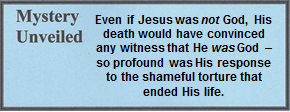
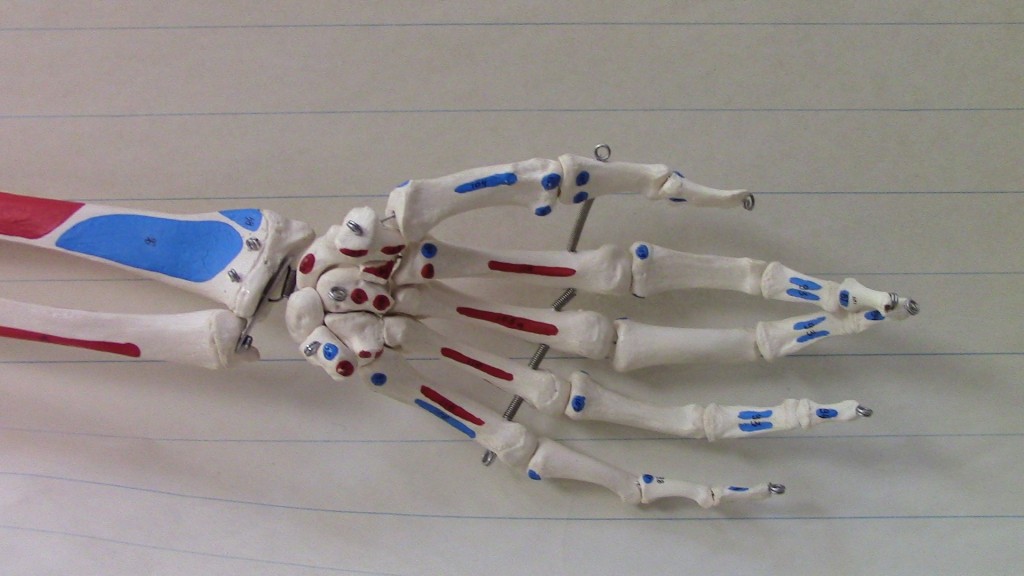
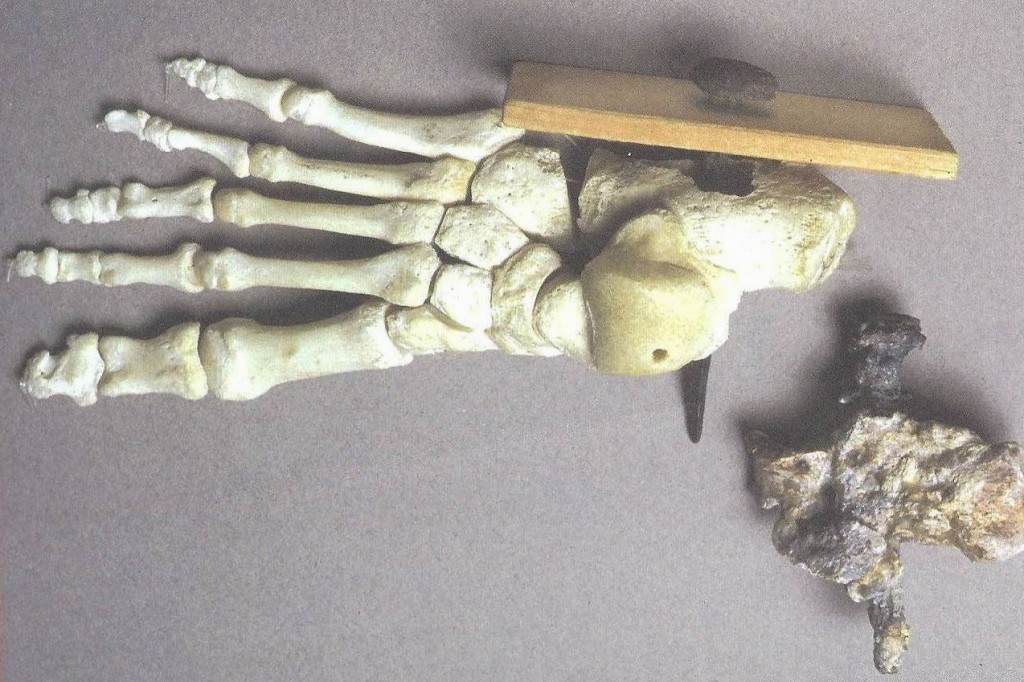
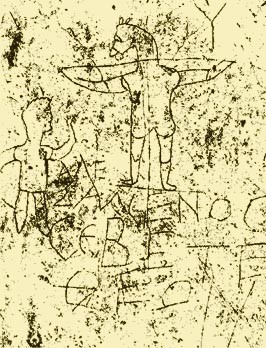
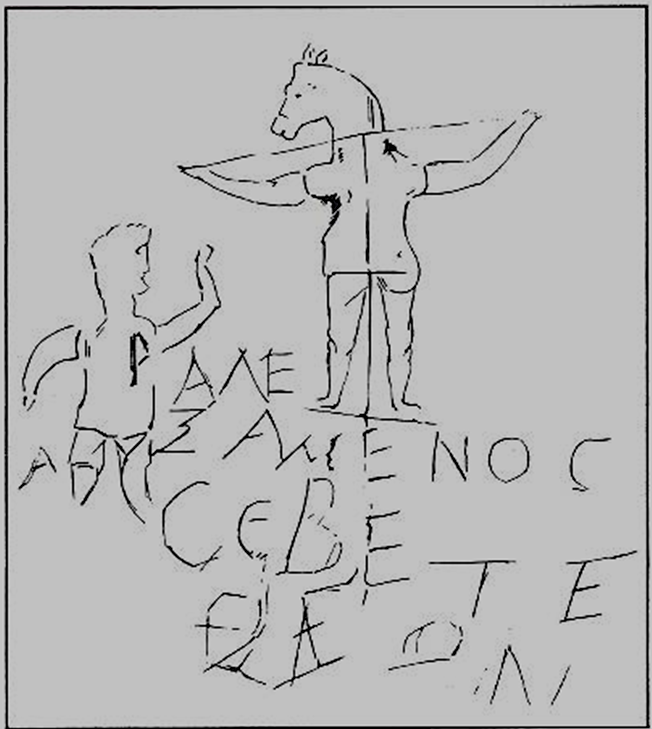
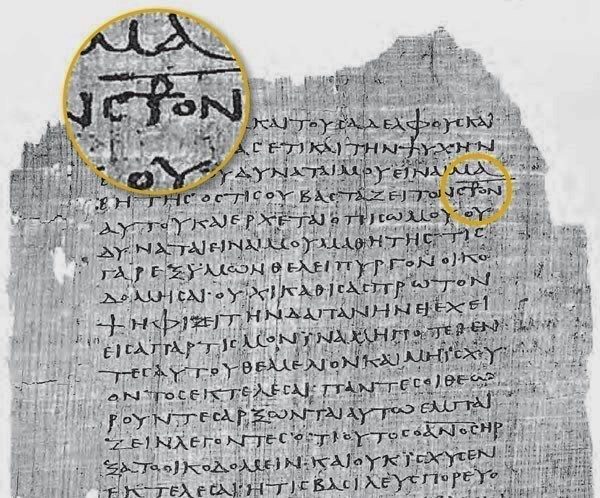
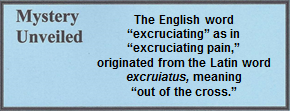
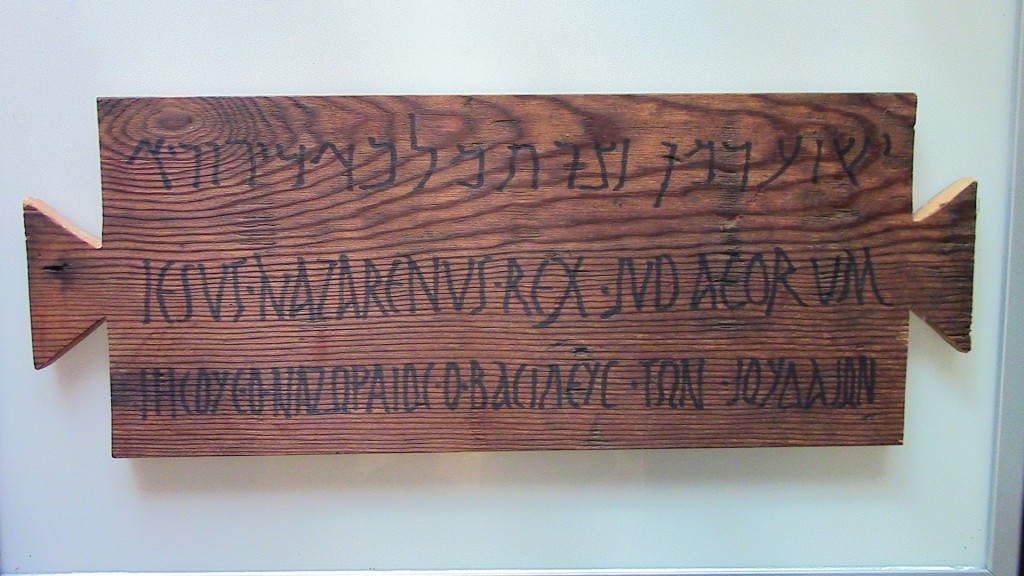 16.01.11.A. AN ILLUSTRATION AND REPRODUCTION OF A ROMAN TITULUS. An illustration (top) of a titulus with reproduction below. The titulus was a wooden placard carried by the condemned or by the lead soldier, on which was written the reason for his execution. Jesus most certainly carried a titulus with the phrase “Jesus, the Natzarene, the King of the Jews” written in three languages: Hebrew, Latin and Greek.
16.01.11.A. AN ILLUSTRATION AND REPRODUCTION OF A ROMAN TITULUS. An illustration (top) of a titulus with reproduction below. The titulus was a wooden placard carried by the condemned or by the lead soldier, on which was written the reason for his execution. Jesus most certainly carried a titulus with the phrase “Jesus, the Natzarene, the King of the Jews” written in three languages: Hebrew, Latin and Greek.